
Ski-Areas > Northern Alps > Isère (38) > Vercors > Vercors-East-Couloirs > Pas Morta
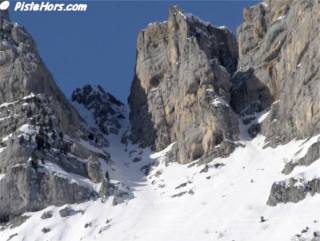
Pas Morta Couloir, Vercors
The Pas Morta (Dead Womans Gulch) is steep but not particularly long, even by the standards of the Vercors range but it proved to be the ideal bolt-hole on a bad weather day. You see the eastern ramparts of the Vercors are striated with cracks and gorges from both the top and bottom but not many actually lead anywhere. From below it is not too critical, you end up in a dead end with some wasted climbing but from above you had better take a few lengths of rope and kit for abseiling. Not somewhere to be skiing around with your eyes closed.
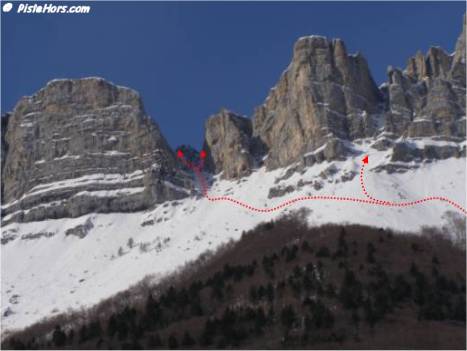
Pas Morta, alternative couloir to the north
The weather in Grenoble didnt look particularly promising with cloud hovering around 1000 meters. The original plan was one of the high peaks in the Devoluy range but we werent sure where the cloud ended. Climbing a wide, open valley in zero visibility requires superb navigational skills and is something to be avoided if you possibly can. A tight couloir is the ideal spot to keep your bearings, if only we could find the entrance. Marika, who recently appeared in a magazine article on the couloirs of the Vercors, assured us she could find the Pas Morta blindfold.
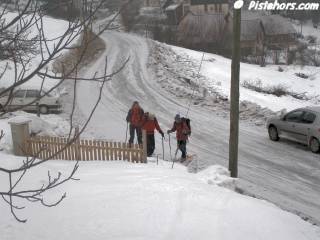
lay-by at Saint-Andéol
The weather at Saint-Andéol was even darker. There was a thin layer of snow on the road but the field was frozen solid and low cloud hovered around 1500 meters hiding the cliff walls above. Occasionally it would lift given a tantalizing glimpse of the couloirs avoid before coming down like a veil.
The forest is pretty open and we soon climbed into a large clearing. The snow felt crusty underfoot. At the top of the clearing we traversed north looking for our couloir. The first possibility was a dead end. The next couloir looked like it would exit but didnt have enough snow to ski some small cliff bands, immediately after was our couloir. Only now the mist had come down and we completely missed it arriving instead at the narrow Pas Etoupe.

Starting the climb
We had stayed high and Marika was having trouble getting grip with her Movement Red Apples. A typical problem with shaped skis on harder snow. Pascal came back to help out. I had abandoned my skis and was wearing crampons in anticipation of the climb. Here the question of aesthetics comes to the fore. Some believe that climbing on foot is a sacrilege for all but the steepest slopes but they are not as old as me and are capable of doing conversions on 40+°angles. It is the same for the descent, and here I am more in agreement. Should you side slip (derapage) when the going gets too tough? The arguments against are that it removes snow in the ski line, it tends to form ruts and steps so that even those that could ski the slope with ease are now put in difficulty and, well if you have to side slip you quite simply shouldnt be there. Of course if there is the risk of windslab you dont want to be doing sauté-pedale turns either.
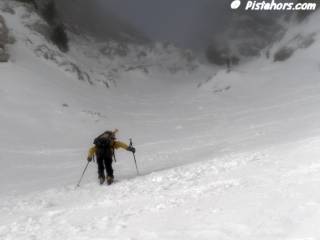
Isabelle in the mist
The couloir itself is large and angled at a fairly constant 40° except for the last 25 meters which steepens to nearer 45°. At about 2/3rds distance the couloir splits in two, the right fork is slightly steeper but this didnt stop a snow shoer climbing it. He was heading to the Vercors plateau and hope to descend by another route, maybe the Peyrouse about 500 meters to the south?
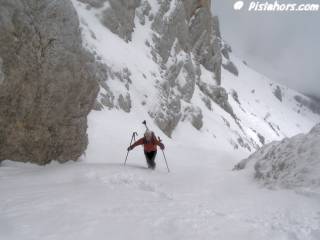
Marika in the Pas Morta
As we reached the last 50 meters the soft snow turned quite slabby. Time to decide what to do next. There was a flat area to the left of the couloir protected by a rock. A good place to stop. A test pit revealed a 20cm slab poorly bonded to the layer beneath. 20cm may not sound much but the BLMS crew who pioneered some of the Vercors routes had a couloir accident when a small slab broke away knocking one of them of his feet. The result, a collision with the couloir side and a broken thigh. Season over.
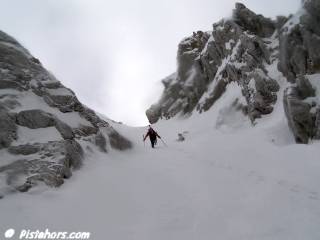
Marika arrives
Marika offered to go ahead to test the slope. A cord might have been nice but we figured that on foot we would penetrate the slab to the more stabilized snow below. The funnel shape of the couloir would also help to retain any slab but safe skiing would be the order of the day for the descent. From the pass you can climb to the 6th tour of Playnet (1797 meters) towards the south. this adds 30 meters to the total.
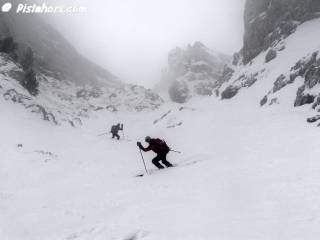
Marika testing the slope
The weather had also closed in and it was hard to see more than a couple of turns ahead. The sound of skis on the hard snow helped locate people above and below. The cloud cover also meant an execrable layer of crust in the forest level. We had made a navigation error on the descent and instead of swinging back to our glade tried to ski directly down through the forest but it proved to be too thick. Isabelle got tied up on some branches at one point.
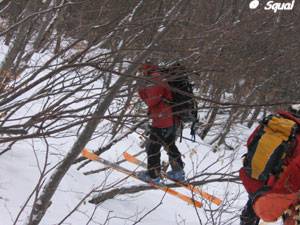
Isabelle branches out
26 January 2006
Participants: Squal, David, Isabelle, Marika, Jean Claude Metayer
GPS: N 44.9571° E 05.5247°, (1889 meters)
Orientation: East
Toponeige Rating: Danger: 2, Climb: PD, Ski: 4.1
Climbing: 940 meters, 3080 ft.
From Grenoble take the motorway towards Sisteron. Leave the motorway at junction 12 (Vif), cross Vif and take the first exit direction Col de l'Arzelier then to Saint Andéol. Cross Saint-Andéol, there is car parking for two cars on the side of the road on the southern side of the village.
<< Pas Etoupe | Vercors-East-Couloirs | Goulot des Chaudieres? >>